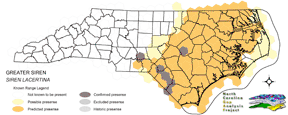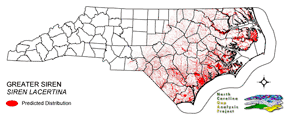
| Taxa: |
| Order: |
| Family: |
| Amphibia |
| Caudata |
| Sirenidae |
| NatureServe Global Rank: |
| NatureServe State (NC) Rank: |
| G5 |
| S4 |
| Federal Status: |
| NC State Status: |
| --- |
| --- |


| Land Unit |
| US Fish & Wildlife Service |
| US Forest Service |
| US National Park Service |
| US Department of Defense |
| NC State Parks |
| NC University System |
| NC Wildlife Res. Com. |
| NC Forest Service |
| NC Div. of Coastal Mgmt. |
| Local Governments |
| Non-Governmental Org. |
| Other Public Lands |
| Private Lands |
| GAP Status 1-2 |
| All Protected Lands |
| Statewide |
| Hectares |
| 75,994.83 |
| 44,455.32 |
| 58,432.68 |
| 471.51 |
| 7,451.19 |
| 19,350.90 |
| 58,949.64 |
| 7,195.77 |
| 3,537.90 |
| 422.37 |
| 18,008.37 |
| 438.66 |
| 1,054,627.83 |
| 160,912.71 |
| 292,431.33 |
| 1,349,336.97 |
| Acres |
| 187,787.28 |
| 109,851.47 |
| 144,390.27 |
| 1,165.13 |
| 18,412.29 |
| 47,817.11 |
| 145,667.70 |
| 17,781.13 |
| 8,742.34 |
| 1,043.70 |
| 44,499.64 |
| 1,083.95 |
| 2,606,041.61 |
| 397,623.89 |
| 722,613.41 |
| 3,334,283.62 |
| % of Dist. on |
| Prot. Lands |
| 26.0 % |
| 15.2 % |
| 19.4 % |
| 0.2 % |
| 2.5 % |
| 6.6 % |
| 20.0 % |
| 2.5 % |
| 1.2 % |
| 6.1 % |
| 6.1 % |
| < 0.1 % |
| < 0.1 % |
| 55.0 % |
| ----- |
| ----- |
| % of Dist. on |
| All Lands |
| 5.6 % |
| 3.3 % |
| 4.3 % |
| < 0.1 % |
| 0.6 % |
| 1.4 % |
| 4.4 % |
| 0.5 % |
| 0.3 % |
| < 0.1 % |
| 1.3 % |
| < 0.1 % |
| 78.2 % |
| 11.9 % |
| ----- |
| ----- |
|
This species is found in a variety of lowland habitats including shallow, mud-bottomed, swamps, ponds, lakes and streams; also in weed-choked ponds, streams, and ditches (Bishop 1943, Leviton 1970, Holbrook 1976, Cochran and Goin 1970). Bottomland backwaters, swamps and semi- to permanent floodplain ponds are preferred (Bishop 1943, Leviton
1970, Holbrook 1976, Cochran and Goin 1970). It has also been collected above floodplains from shallow roadside ditches and rocky areas along swift flowing streams (Bishop 1943). Found in the same lowland habitats as lesser siren, however may utilize river margins in larger, more open water bodies to a greater extent. Shelters in substrate among course debris, roots of woody and herbaceous plants, or crevices and burrows in subsurface and surface banks. Capable of moving overland to other nearby aquatic sites. NATURE SERVE GLOBAL HABITAT COMMENTS: Shallow, muddy, weed-choked water: swamps, ponds, lakes, streams, ditches. Found among thick vegetation, under rocks and logs, or burrowed in bottom mud by day. Burrows into bottom mud if water dries up. Eggs are laid in water in small clusters on bottom. |
| Code | Name | Description | NC Natural Heritage Program Equivalent |
| 75 | Tidal Swamp Forest | Swamp tupelo dominated forest with or without black tupelo and/or cypress trees. Restricted to the tidal zones in the coastal plain. May have inclusions of coastal red cedar woodlands. | Tidal cypress - gum swamp |
| 380 | Coastal Plain Fresh Water Emergent | Emergent vegetation in fresh water seepage bogs, ponds and riverbeds of the coastal plain. Includes alliances dominated by sedges, eelgrass, as well as cane found in unforested cane-brakes. | Small Depression Pond, Sandhill Seep, Floodplain Pool, Unforested Floodplain Canebrake, Riverscour Prairies, Vernal Pools |
| 50 | Coastal Plain Mixed Bottomland Forests | Includes forests dominated by a variety of hardwood species, including sweetgum, cottonwood, red maple. | Coastal Plain Bottomland Hardwood (in part), Coastal Plain Levee Forest |
| 49 | Coastal Plain Oak Bottomland Forest | Bottomland forests dominated by deciduous oak alliances. Oaks represented can include swamp chestnut, cherrybark, willow, and/or overcup oak. Inclusions of loblolly pine temporarily flooded forests occur in patches. Hydrology is temporarily to seasonally flooded. | Coastal Plain Bottomland Hardwoods (in part) blackwater subtype, brownwater subtype |
| 41 | Peatland Atlantic White-Cedar Forest | Dense stands of Atlantic white cedar with saturated hydrology. Can include swamp tupelo, red maple, and pond pines with a moderate shrub and herb layer. | Peatland Atlantic White-Cedar Forest |
| 30 | Cypress-Gum Floodplain Forests | Swamps dominated by black or swamp tupelo with or without Taxodium. Seasonally to semi-permanently flooded hydrology. | Cypress-Gum Swamps |
| 78 | Pond-Cypress - Gum Swamps, Savannas and Lakeshores | Cypress dominated swamps and lakeshores. Can include bays dominated by pond cypress or shorelines of coastal plain lakes with a narrow band of cypress. | Non-riverine Swamp Forest, Natural Lakeshores (in part) |
| 385 | Oak Bottomland Forest and Swamp Forest | The swamp chestnut oak, cherrybark oak, shumard oak and sweetgum alliance is one representative. Other alliances are dominated by water, willow, and overcup oaks. Swamp forests can be dominated by sweetgum, red maple, and black gum being dominant. Loblolly can occur in combination with sweetgum and red maple, or with tulip poplar. Includes saturated and semi- to permanently flooded forests in the mountains. | Piedmont/Mountain Bottomland Forest, Piedmont/Mountain Swamp Forest |
| 87 | Pocosin Woodlands and Shrublands | Includes pond pine woodland, low pocosin and high pocosin shrub dominated areas. Canebrakes and bay forests may be present. | Pond Pine Woodlands, Peatland Canebrake, Small Depression Pocosin |
| 67 | Wet Longleaf or Slash Pine Savanna | Wet flatwoods and pine savannas, typically dominated by longleaf pines, but slash or pond pines may be the dominant pines. | Wet Pine Flatwoods |
| 97 | Mesic Longleaf Pine | Longleaf pine woodlands without a major scrub oak component. Slash or loblolly pines may be present as well. | Mesic Pine Flatwoods |
| 238 | Piedmont/Mountain Submerged Aquatic Vegetation | Seasonally to permanently flooded areas with aquatic vegetation. Waterlily, pondweed, hydrilla smartweed are a few of the species that can occur. | Piedmont/Mountain Semipermanent Impoundment (in part) |
| 239 | Piedmont/Mountain Emergent Vegetation | Emergent vegetation of all wetland hydrologies. Sites would commonly support species such as tussock sedge, rushs, and cattail alliances. | Rocky Bar and Shore (in part) |
| 269 | Floodplain Wet Shrublands | Saturated shrublands of the Piedmont, includes buttonbush, swamp-loosestrife, decodon and alders. | Piedmont/mountain Semipermanent Impoundment |
| 384 | Piedmont/Mountain Mixed Bottomland Hardwood Forests | Includes temporarily to seasonally forests dominated by hardwood species. Hardwoods include sweetgum, red maple, sycamore which co-occur in a mosaic of bottomland and levee positions. Includes alluvial hardwood forests in the mountains. Hemlock and white pine may occur as inclusions, but are generally mapped separately. | Piedmont/Mountain Alluvial Forest, Piedmont/Mountain Levee Forest |
| 8 | Open water | Open water without aquatic vegetation. | No equivalent |
|
Flores Villela, O., and R. A. Brandon. 1992. SIREN LACERTINA (Amphibia:Caudata) in northeastern Mexico and southern Texas. Annals of Carnegie Museum 61(4):289-291.
Cochran, D. M., and C.J. Goin. 1970. The new book of reptiles and amphibians. New York: Putnam. Mount, R. H. 1975. The Reptiles and Amphibians of Alabama. Auburn University Agricultural Experiment Station, Auburn, Alabama. vii + 347 pp. Holbrook, J. E. 1976. North American Herpetology. Athens?, OH: Society for the Study of Amphibians and Reptiles. Behler, J. L., and F. W. King. 1979. The Audubon Society field guide to North American reptiles and amphibians. Alfred A. Knopf, New York. 719 pp. Martof, B. S., W. M. Palmer, J. R. Bailey, and J. R. Harrison, III. 1980. Amphibians and reptiles of the Carolinas and Virginia. University of North Carolina Press, Chapel Hill, North Carolina. 264 pp. Martof, B. S. 1973. Siren lacertina. Cat. Am. Amph. Rep. 128.1-128.2. |
For more information please contact them at:
NC-GAP Analysis Project
Dept. of Zoology, NCSU
Campus Box 7617
Raleigh, NC 27695-7617
(919) 513-2853
www.basic.ncsu.edu/ncgap